Kilian & Keeley Excel on Illinois Interstate Complete Closure
BY AsphaltPro Staff
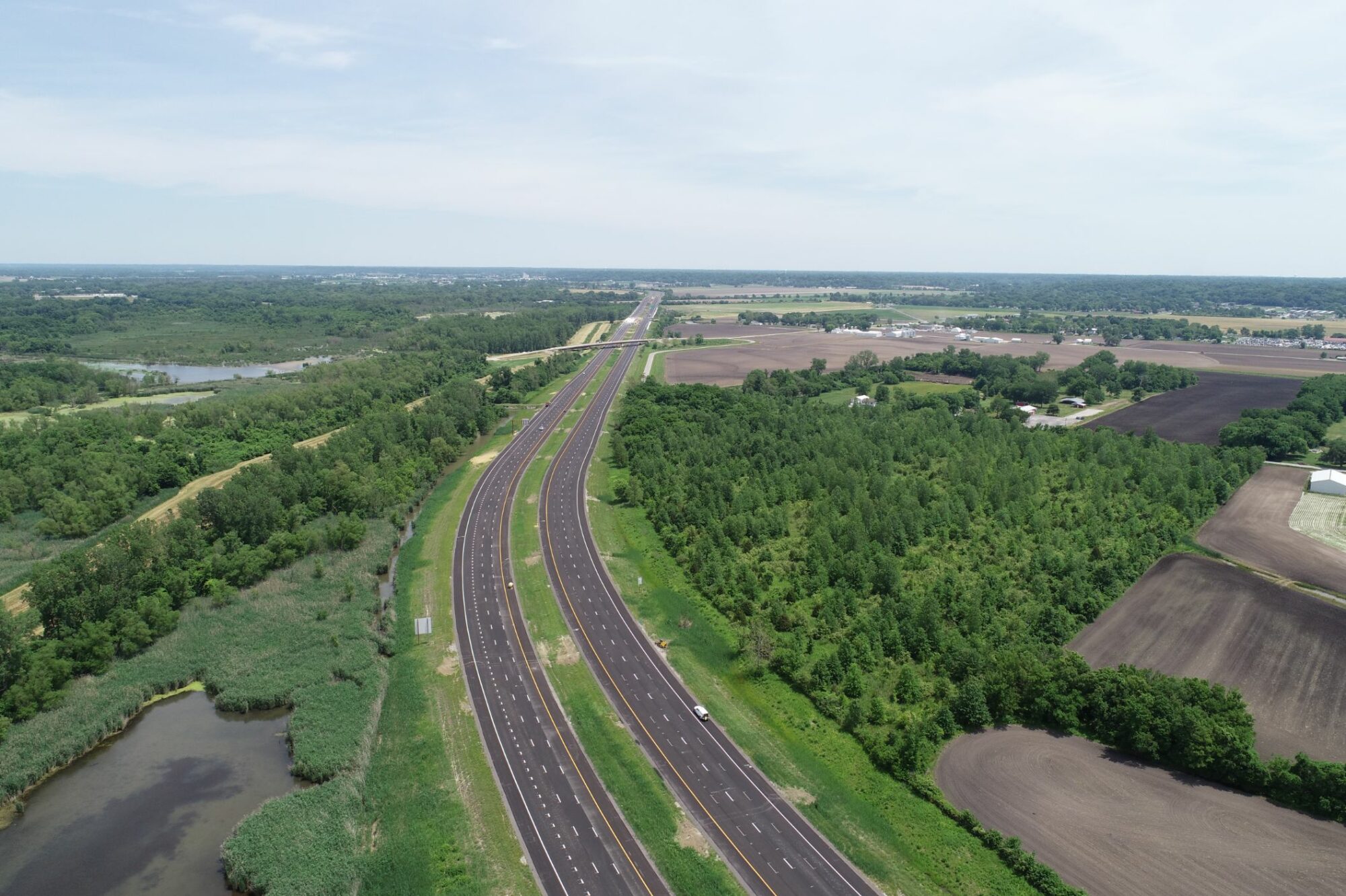
In June 2019, Illinois Governor J.B. Pritzker signed into law the state’s first capital plan in nearly a decade – and the largest in state history. The historic, bipartisan bill, Rebuild Illinois, aims to make $45 billion worth of investments in roads, bridges, railroads, state facilities and more by 2025.
A $67 million project on Interstate 255 was among the first Rebuild Illinois projects. The Kilian Corporation, Mascoutah, Illinois, and its partner on the joint venture, Keeley & Sons, East St. Louis, Illinois, bid the job in November 2019 and completed it Oct. 28, 2020.
I-255 is a six-lane interstate that loops around the St. Louis Metro East area on the Illinois side of the Mississippi River. The concrete road had badly deteriorated over the years. “There were a tremendous amount of potholes everywhere,” said Steve Williams, operations manager at Kilian.
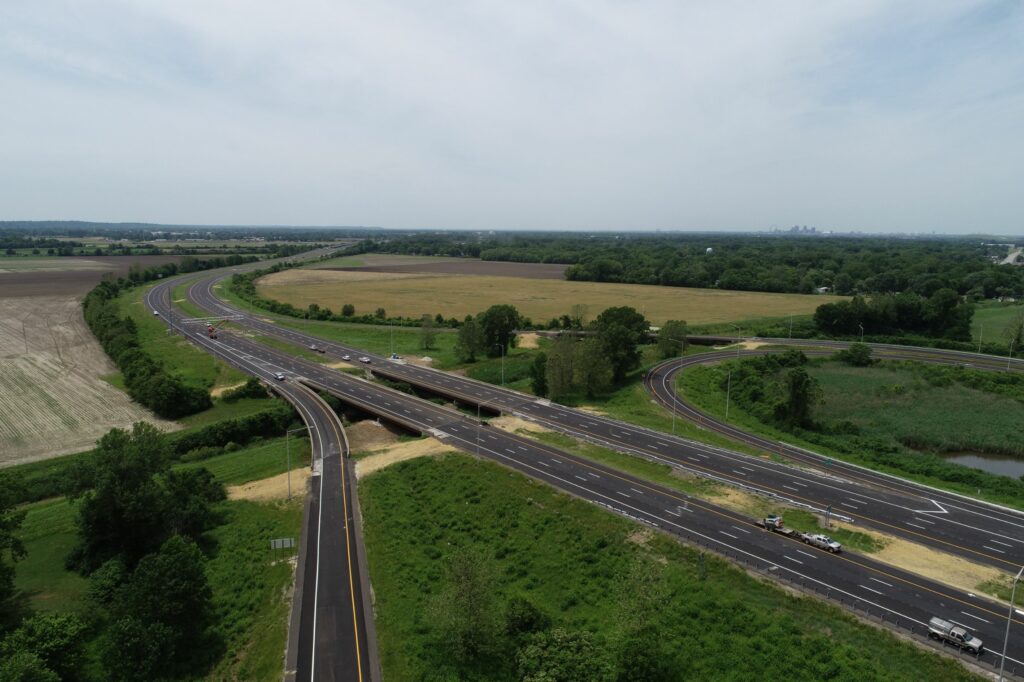
I-255 is a six-lane interstate that loops around the St. Louis Metro East area on the Illinois side of the Mississippi River.
This particular section of I-255 has an average annual daily traffic of 50,000. “There’s a tremendous amount of truck traffic on this portion of the interstate, because there are quite a few quarries along the Mississippi River,” Williams said, adding that there are four quarries within 10 miles of the project. There’s also a lot of north-south truck traffic that uses I-255 to avoid traveling through downtown St. Louis. “St. Louis isn’t very conducive to truck traffic, and this is a major route to sidestep that.”
Because the road experiences such heavy use, closing any lanes for construction was likely to create major problems. The complete closure enabled cheaper, faster and safer construction, reducing the completion time from 4 years to 10 months while saving $14 million and increasing safety both for workers and drivers.
Although Kilian wasn’t involved in the decision to close 255 during construction, Williams said it was a smart move. “If IDOT elected to do periodic lane closures, the traffic snarls would have been so bad that our trucks wouldn’t be able to get to us,” Williams said. And, he added, Kilian’s crews prefer the complete closure to what would have been the most likely alternative of completing the job at night. “So much work in the Metro-East area these days is happening at night, and it really begins to wear out families and affects the ability to retain employees.”
“Being able to work in the day and having 24 hours a day available to us took the handcuffs off and allowed us to be creative with scheduling and methods,” Williams said.
Complete Closure, Complete Control
The work zone extended from I-55/70 to Illinois 15, and was divided by I-64 into two construction phases, north of I-64 and south of I-64. In addition to paving the 7.7-mile section of interstate, the job also required new underdrainage, a large quantity of pavement patching, guardrail replacement, and 20 bridge decks requiring a wide range of rehabilitation work.
The north section was closed from Feb. 1 to June 13, 2020, and the south section, June 13 to Oct. 28, 2020. Despite the safety and efficiency benefits of completely closing the interstate, this also presented unique challenges.
“We had to establish our own rules for working on a closed interstate,” Williams said. They posted 30 mile-per-hour speed limit signs throughout the work zone. They also posted directional signs to ensure everyone drove in the correct lanes within the job site, just as if it were an open interstate.
Williams recalled one of the owners at Keeley & Sons questioned the need for such a low speed limit in a closed work zone. “But then he drove through the work zone at 15 miles per hour and felt like even that was too fast because there was so much activity going on.”
The key to working at a tremendous speed was establishing specific areas for each crew and subcontractor, and everyone was expected to honor the designated areas and stick to their individual schedules. “We made a rule that no one from one group could go into another group’s area without their permission,” Williams said.
Another consideration they had to make was at the entrances to the work zones. “We used flashing arrow boards and large signs telling the public not to follow a truck into the work zones,” Williams said, adding that trucks could only enter near one of those signs. “Once they pulled in, they were required to come to a complete stop to ensure no one followed them in.” Thankfully, Williams said, it was very rare that anyone unauthorized entered the work zone. The few times it did happen, he said, “we’d run them off really fast. Everyone could tell when someone who did not belong there has entered the job site.”
Once these safety protocols were established, Kilian was able to get to work – and quickly. “With the interstate being closed, a lot of the obstacles we’d normally face weren’t there,” Williams said. “It allowed us to really accelerate our work.”
And pace was paramount for this particular job, with a $50,000 per day penalty for running over schedule. They could also earn a bonus of $50,000 per day for up to 20 days for a total bonus of $1 million for early completion.
Over the years, Kilian has built a niche for itself performing large, fast-paced projects, “the kinds of projects that intimidate others,” Williams said. “We’ve assembled an amazing team that can look at a large project and know that we’re prepared to take it on.” The type and pace of work was similar to previous Kilian jobs, except this one “went on and on for months instead of weeks,” Williams said. The company had to make sure its workforce didn’t get exhausted by the work and risk creating safety issues by rotating various employees out to other projects to get a break.
Choosing subcontractors who could also work at that pace and scale was key, as was working with a partner they could trust. Kilian and Keeley & Sons have worked together on several joint ventures over the years. “Working that fast and at that large of scale, we needed a lot of trust in each other,” Williams said.
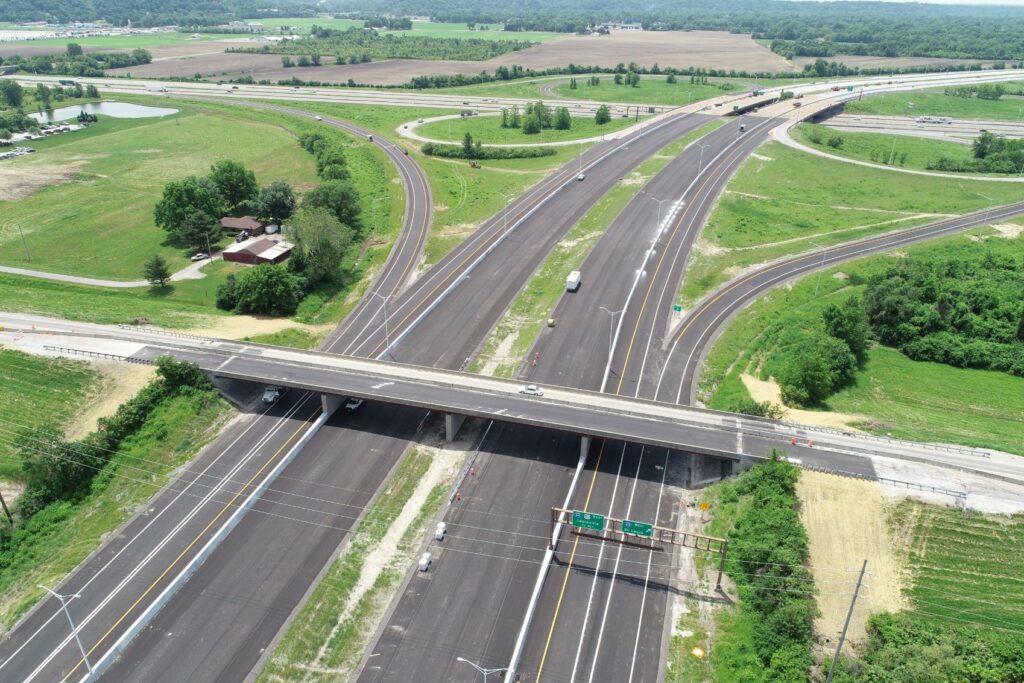
Need For Speed
Kilian and Keeley & Sons bid the job in November 2019 and started at the end of December with prep work in advance of the shutdown on I-255. This included 23,000 square yards of patching, performed by Keeley & Sons, along detour routes as well as on the second phase section of I-255, “to make sure it didn’t fall apart in the meantime,” Williams said. They also widened small intersections along the detour routes in advance of increased traffic.
On Feb. 1, they closed the northern section of I-255 and began work on the underdrainage. “Our rule was we couldn’t take any bridge out of action until the underdrains came across,” Williams said. “But as soon as they did, we shut that bridge down.” The bridge work was shared by Kilian and Keeley & Sons.
After the bridge work was complete, milling and paving could begin. The milling subcontractor, Kaskaskia Engineering Group (KEG), Belleville, Illinois, milled off one inch of concrete in the driving lanes with their Wirtgen milling machines. The job originally called for milling half an inch off the shoulders and driving lanes, but Kilian suggested milling the shoulders might not be necessary. “The shoulders were almost new,” he said. Meanwhile, the driving lanes had a lot of surface cracking. Killian suggested milling 1 inch off the driving lanes for increased longevity and smoothness and leaving the shoulders as is. This change would save the DOT $500,000.
Ultimately, IDOT liked the idea and chose to spend their savings – plus an additional $500,000, for a total of $1 million – on additional thickness on the mainline. The original bid was two 2-inch lifts of SMA asphalt, but this was changed to one 2.5-inch lift followed by a 2-inch lift.
The interstate is three lanes in each direction, plus 10-foot shoulders, for a total of 52 for 56 feet wide on each bound along with 22 interchange on/off ramps. At 7.7 miles long, Kilian paved roughly 55 lane miles plus ramps over the course of 45 days of paving with its Caterpillar AP1000 pavers and Weiler material transfer device.
In total, the job required 150,000 tons of asphalt, 81,500 of which was SMA, made at two asphalt plants belonging to Kilian’s sister company Asphalt Sales and Products. They had two plants equidistant from the project, and equipped both with cellulose blowers to add cellulose fibers into the SMA mix, as well as dust run-a-round systems. “We wanted to make sure both plants were prepared to make SMA at all times,” Williams said. “SMA doesn’t have a lot of fines, so it likes to drain down if you don’t have the cellulose fibers in it.”
The company predominantly relied on its plant north of the job, in Roxana, Illinois, because its staff had more experience with SMA. “We were confident they’d be able to run that mix at high efficiency and quality,” Williams said. The plant south of the project, in O’Fallon, Illinois, also produced mix when needed, though it tends to be the busier of the two.
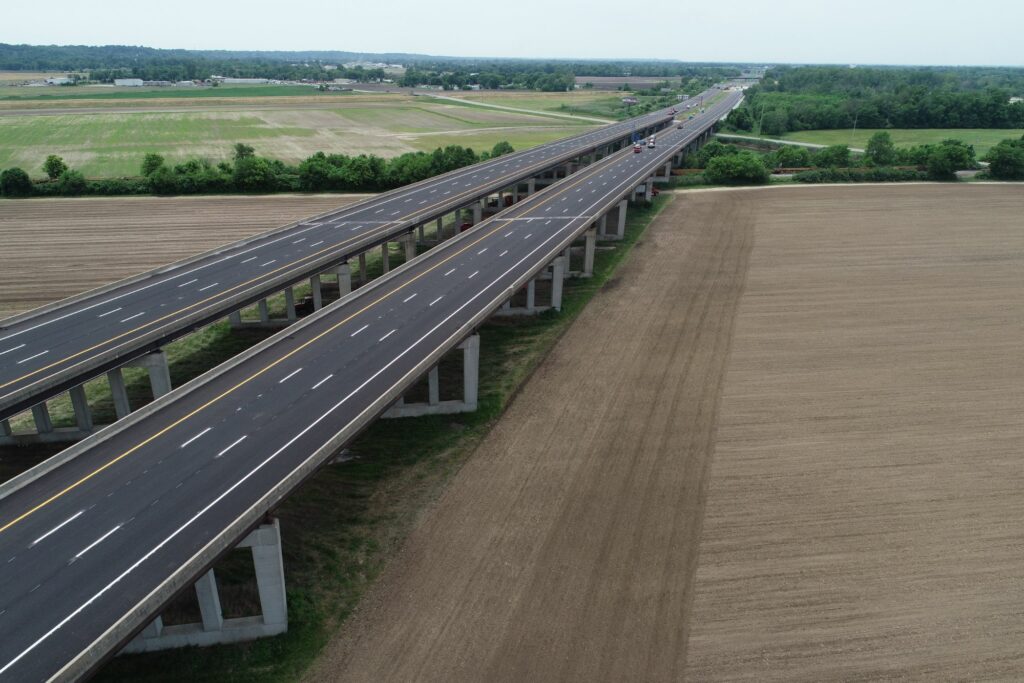
The complete closure of I-255 enabled cheaper, faster and safer construction, reducing the completion time from 4 years to 10 months.
Confidence to Overcome Challenges
In addition to the unique challenges of a complete closure, the I-255 job had other quirks. For example, mainline bridges required 28,000 square yards of waterproof membrane system. IDOT usually uses coal tar emulsion and fiberglass sheets, Williams said, “but it’s an extremely labor-intensive process.” Plus, coal tar was not in production during the time of year they were performing the bridge work. “Usually you can’t get it until mid-April at the earliest.”
Kilian got creative about how they could overcome those twin challenges, proposing an alternative waterproof membrane system: full lane sealant. They could apply the same longitudinal joint sealant material on the bridge decks, but applied in full-width passes versus in 18-inch wide passes and then overlay it. “We did a project in 2018 using this material as a waterproof membrane and it took a lot of unpredictability out of the job.” They conversed with IDOT, conveying how using FLS would bypass labor and material availability issues to ultimately speed up the project, while saving quite a bit of money. “IDOT thought it was a good idea,” Williams said. “Without that change, we could have easily finished 15 days late because the other process is so laborious and unpredictable. Now, IDOT has a new process they feel comfortable doing that they can use on future projects.”
In addition to a large quantity of pavement patching, bridge deck rehabilitation, milling and paving, the project also included replacing more than 29,000 feet of guardrail. They also removed more than 33,000 feet of single-faced concrete barrier wall and replaced it with more than 19,000 feet of new double-faced barrier.
Another hurdle was the weather. Because they were starting in February, they were still experiencing occasional snow. Kilian ended up hiring a snow removal crew to be on standby just in case of snowfall so their employees could get to work. Ultimately, this was only necessary for two days. “But if we’d had the same weather we had in February 2019, there’s no way we’d have gotten any bonus for early completion.”
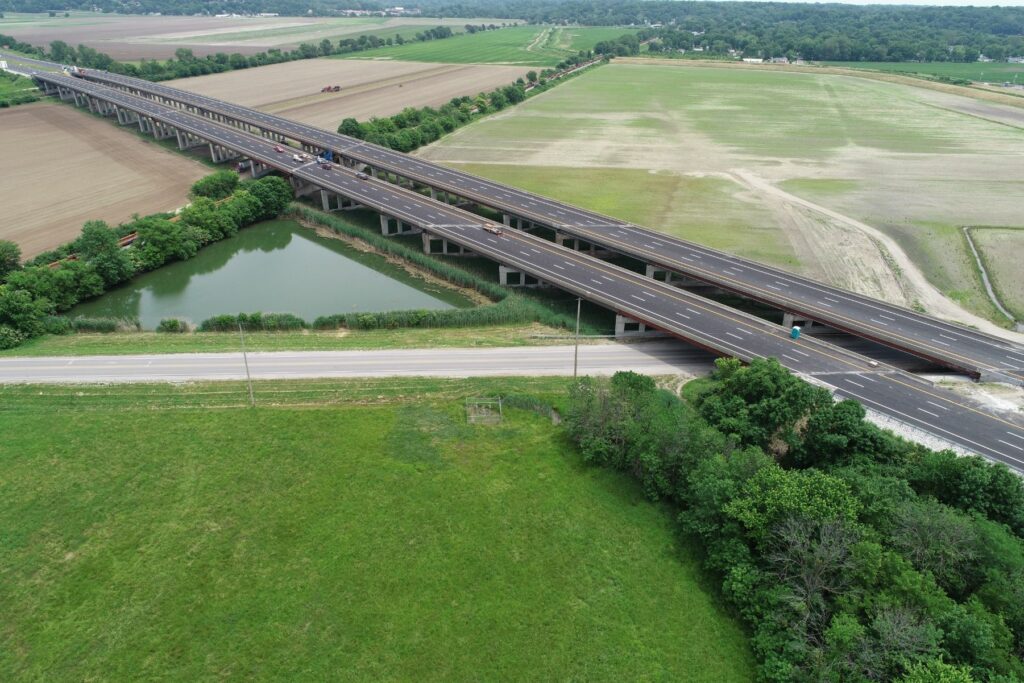
This particular section of I-255 has an average annual daily traffic of 50,000, with heavy truck traffic due to area quarries and north-south truck traffic that uses I-255 to avoid traveling through downtown St. Louis.
Covid presented yet another challenge. “When the first shutdown started Feb. 1, we hadn’t even heard of Covid yet,” Williams said. The pandemic, and accompanying fear, quickly escalated. “Even though we were deemed essential employees, and that helped tremendously, we were having to convince people to come to work. We had to do a lot to alleviate peoples’ fear in those early days.” That included social distancing, wearing masks, setting up hand washing units throughout the job, and additional toolbox talks and safety instructions to ensure employees were working safely and also to alleviate fears.
“It’s amazing we were able to get done as early as we did with what we were facing,” Williams said. “I’m proud of the fact that our company is somewhat fearless. A job like this requires confidence that you’ll be able to figure out a way around any obstacles that arise.”
With a deadline of Nov. 24, Kilian was able to get the job open on Oct. 28 and received the maximum bonus. Kilian earned an additional $345,000 in pay for performance (PFP) bonuses for various HMA mixtures.
For its performance on I-255, Kilian was recognized as IDOT’s Contractor of the Year. Although they’d won the award in 2011 for a similarly large, fast-paced project, Williams was as proud as if it had been the company’s first.
He attributes the project’s overall success to teamwork. “Everyone has to buy into the mission of not only constructing at a fast pace, but at high quality,” Williams said. “Our team borders on being a family, and that’s required to do something at this size, speed, quality and safety. We’re very proud of that and of our team.”
Living just 15 minutes from this section of I-255, and traveling it often, Williams is also proud of the pavement he and his crews so expertly paved. “Motorcycles scarcely used to ride on this section of interstate for fear of hitting one of the many potholes,” he recalled. “Now, they just love it. It’s a source of pride in this area.”
Furthermore, the project is a source of pride for the state as a symbol of early success in its effort to Rebuild Illinois.
